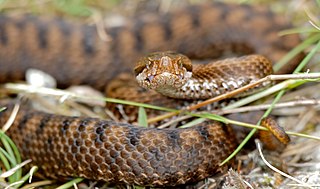
Vipera aspis is a viper species found in southwestern Europe. Its common names include asp, asp viper, European asp, and aspic viper, among others. Like all other vipers, it is venomous. Bites from this species can be more severe than from the European adder, V. berus; not only can they be very painful, but approximately 4% of all untreated bites are fatal. The specific epithet, aspis, is a Greek word that means "viper." Five subspecies are currently recognized, including the nominate subspecies described here.

Echis pyramidum, known as the Northeast African carpet viper, Egyptian saw-scaled viper, and by other common names, is a species of viper endemic to Northeast Africa and the Arabian Peninsula. Like all other vipers, it is venomous. Three subspecies are currently recognized, including the nominate subspecies described here.

The viperine water snake or viperine snake is a semiaquatic, fish-eating natricine water snake. Despite its common names, it is not a member of the subfamily Viperinae. It was given its common names due to exhibiting a dorsal colour pattern that superficially resembles that of sympatric adder species. In comparison to other Natrix species its head is also somewhat wider and more distinct from the neck. Like most members of the Natricinae it possesses a venom gland on each side of the upper jaw that produces a mild venom that may play a role in swallowing or digestion. The gland is not associated with an enlarged specialized tooth and the venom has to be applied by chewing. The species usually does not bite as a means of defense, and the effect of a bite would be harmless to humans.

The Tenerife gecko, also known commonly as Delalande's gecko and the Tenerife wall gecko, is a species of lizard in the family Phyllodactylidae.

Savigny's fringe-fingered lizard is a species of lizard in the family Lacertidae. The species is endemic to western North Africa.

Lilford's wall lizard is a species of lizard in the family Lacertidae. The species is endemic to the Balearic Islands, Spain.

The Aeolian wall lizard, also known commonly as Raffone's wall lizard, is a species of lizard in the family Lacertidae. The species is endemic to Italy.

The horseshoe whip snake is a species of snake in the family Colubridae. The species is native to southwestern Europe and northern Africa.

The green whip snake or western whip snake is a species of snake in the family Colubridae.
Macroprotodon abubakeri is a species of snake in the family Colubridae. It is one of four species in the genus Macroprotodon.

Macroprotodon is a genus of snakes in the family Colubridae. All of the member species of the genus are commonly known as false smooth snakes.

The western false smooth snake or Iberian false smooth snake is a species of snake in the family Colubridae.

The Italian Aesculapian snake is a species of snake in the Colubridae family.

The European ratsnake or leopard snake, is a species of nonvenomous colubrid snake endemic to Europe, Asia Minor, and the Caucasus.

Malpolon monspessulanus, commonly known as the Montpellier snake, is a species of mildly venomous rear-fanged snake.

Elaphe quatuorlineata is a member of the family Colubridae. The four-lined snake is a non-venomous species and one of the largest of the European snakes.














